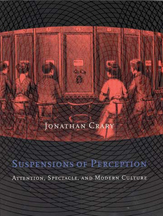 |
Jonathan Crary. Suspensions of Perception: Attention, Spectacle, and Modern Culture. Cambridge: The MIT Press, 2001.
I was tipped off by Peter Stallybrass and Allon White in The Politics and Poetics of Transgression (1986) to think that this book on perception at the dawn of the modern era in Europe referenced Carnival. It does, especially Chapter III: Illuminations of Disenchantment. In this chapter, Crary, the foremost historian of Western Modernity and its aftermath, highlights the dual nature of George Seurat’s Parade de Cirque: it is modern on account of the pointillist technique yet refers to a pre-modern European entertainment, Carnival, hinted at in the reference to the parade, and a contemporary popular pastime, the circus. The contemporaneity between Seurat’s painting and Melton Prior’s lithograph of a carnival parade in Port-of-Spain, Trinidad, also from 1888 has been instrumental in helping me shape my discourse around Carnival in the Americas as a modern cultural practice and contemporary art form. This is, for instance, relayed in my most recent exhibition “EN MAS’: Carnival and Performance Art of the Caribbean.” |